Jim Shooter's Blog, page 6
November 17, 2011
VALIANT Logo Design Sketches
JayJay here. Jim is in the city all day today and hasn't gotten today's blog written. But when I was digging through old files yesterday, looking for those Marvel ad rate cards, I ran across some of my old logo sketches from our VALIANT days. I think I was able to do some ok designs in spite of Jim's direction. Heh.
In the very beginning of VALIANT we had a lot of discussion about the cover design and wanting to give the covers a distinctive look. I don't think I have any of those very early cover designs, but there were many. Jim's final decision was to make every logo into a box at the top of the cover. At the time I was opposed it, but as usual he was right. In his way. We weren't winning any awards for graphic design, but you could spot a VALIANT book a mile away. Jim, the big picture guy, has consistently been able to see things on a whole 'nother level from most people, me included.
Here are some sketches for the Harbinger logo. We spent a lot of time refining that bird, huh?
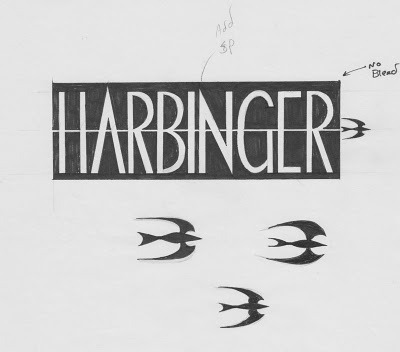
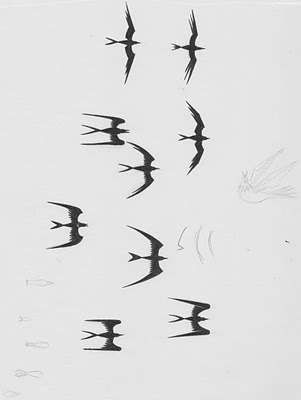
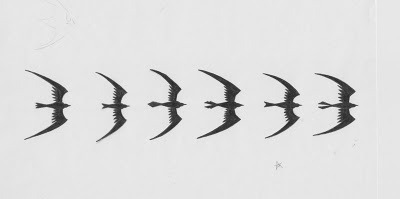
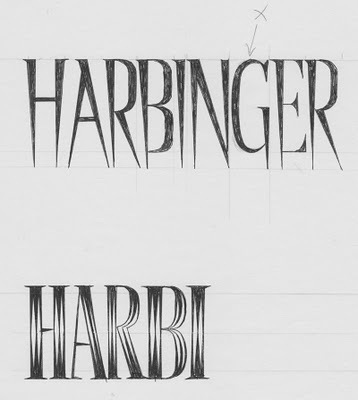 Early type explorations
Early type explorations
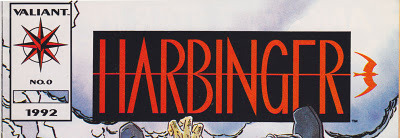 The final logoHere are three X-O sketches. I think we had a pretty good idea of what we wanted and I was just doing refinements at this point.
The final logoHere are three X-O sketches. I think we had a pretty good idea of what we wanted and I was just doing refinements at this point.
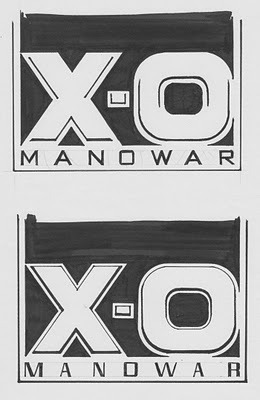
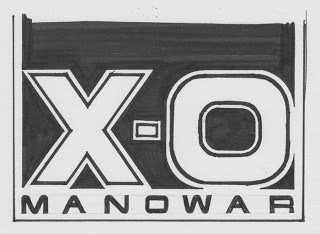
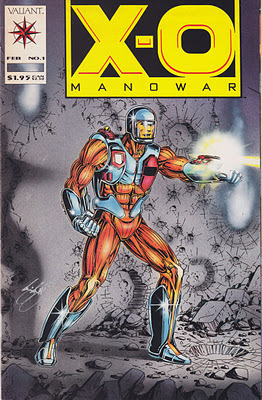 The finalI was in the process of creating the final artwork for this Geomancer logo when we were fired from VALIANT. I still have the incomplete art, so I think it was never used for anything.
The finalI was in the process of creating the final artwork for this Geomancer logo when we were fired from VALIANT. I still have the incomplete art, so I think it was never used for anything.
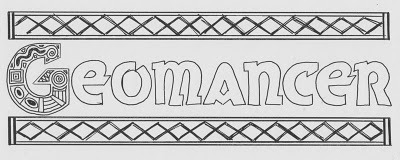
Jim should be back to the blog tomorrow, but... Shhh! Nobody tell him I took over!
In the very beginning of VALIANT we had a lot of discussion about the cover design and wanting to give the covers a distinctive look. I don't think I have any of those very early cover designs, but there were many. Jim's final decision was to make every logo into a box at the top of the cover. At the time I was opposed it, but as usual he was right. In his way. We weren't winning any awards for graphic design, but you could spot a VALIANT book a mile away. Jim, the big picture guy, has consistently been able to see things on a whole 'nother level from most people, me included.
Here are some sketches for the Harbinger logo. We spent a lot of time refining that bird, huh?



 Early type explorations
Early type explorations The final logoHere are three X-O sketches. I think we had a pretty good idea of what we wanted and I was just doing refinements at this point.
The final logoHere are three X-O sketches. I think we had a pretty good idea of what we wanted and I was just doing refinements at this point.

 The finalI was in the process of creating the final artwork for this Geomancer logo when we were fired from VALIANT. I still have the incomplete art, so I think it was never used for anything.
The finalI was in the process of creating the final artwork for this Geomancer logo when we were fired from VALIANT. I still have the incomplete art, so I think it was never used for anything. 
Jim should be back to the blog tomorrow, but... Shhh! Nobody tell him I took over!
Published on November 17, 2011 09:01
November 16, 2011
Comic Book Distribution - Part 2
More on Newsstand Distribution
Mob involvement? Well….
Anytime you have businesses holding monopolies in certain territories, like the linen business south of Canal, or the poster "sniping" business (putting up advertising posters on walls and fences) in Manhattan, garbage hauling in the New York metro area, or the parking racket—did I say racket?—I meant industry, around New York…
…or the periodicals distribution business…
…the notion of mob involvement has to cross your mind.
The founder and patriarch of Hudson News, Robert "Bobby" Cohen, was famously "connected" and "involved" with organized crime. Once he copped a plea on twenty counts of bribery in exchange for being sentenced to probation instead of prison time
Fun Fact: Bobby Cohen's daughter Claudia was Ronald O. Perelman's second wife. Perelman had control of Marvel for a while, of course. After I was gone, by the way.
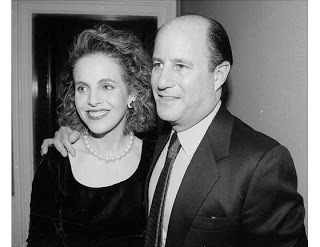 Claudia Cohen and Ronald PerelmanDuring the early days of the Direct Market, Marvel's V.P. of Circulation, Ed Shukin, a long-term veteran of the magazine distribution trade, made it very clear to me that among those we dealt with on the newsstand distribution side there were some pretty nasty characters, and he was openly concerned about the possibility of violent reprisals.
Claudia Cohen and Ronald PerelmanDuring the early days of the Direct Market, Marvel's V.P. of Circulation, Ed Shukin, a long-term veteran of the magazine distribution trade, made it very clear to me that among those we dealt with on the newsstand distribution side there were some pretty nasty characters, and he was openly concerned about the possibility of violent reprisals.At one point, I wanted to stop shipping to an ID that was blatantly screwing us. Ed dug his heels in. He said the owner there wasn't someone you wanted to piss off. It wasn't worth two broken legs.
Fun Fact: Warner Communications executives Jay Emmet and Solomon Weiss were implicated in a racketeering scam. Weiss was convicted, but managed to avoid prison time. Warner, of course, owned DC Comics. Vince Colletta, who worked at DC Comics and seemed to know a lot about the matter told me that Weiss was "taking the fall" to protect someone higher up. There weren't many higher ups.
Fun Fact: Warner higher-up, CEO Steve Ross cut his teeth in the parking racket—I mean industry.
Fun Fact: Bobby Cohen was a long time business partner of Time Inc., which Warner, under Ross, purchased.
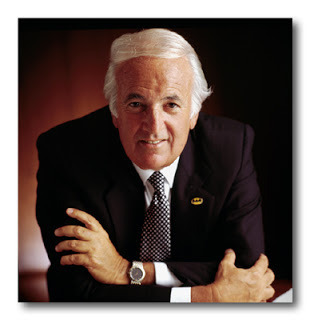 Steve RossSuch a small world….
Steve RossSuch a small world….Additional reading:
http://money.cnn.com/2010/01/05/news/companies/ronald_perelman_revlon.fortune/index.htm
A couple of interesting clips starring Manny Gerard, former executive of Warner Communications:
http://www.myspace.com/video/greg-thompson/manny-gerard-former-co-ceo-of-warner-communications/40711507
http://www.thoughtequity.com/video/clip/5112665930_021.do
Anyway….
Someone asked if the newsstand distribution process I spoke of yesterday applied to non-comics periodicals as well as comics. Yes, with a few notes:
Big Circulation Magazines
Big circulation magazines have a lot of clout. They get much better treatment by the National Distributor, which reallyreallyreally wants their account and loveslovesloves having a Forbes, Marie Claire or People among their offerings.
Local Independent Distributor Wholesalers (ID's) need the big-circ titles. The retailers they serve would scream if they couldn't get Elle or Parenting, and remember, ID's are usually monopolies in their areas, so it's not as if a news dealer would have an alternative source. ID's have to play more fairly with big-circ titles because the threat of being cut off by a GQ means something.
Besides, ID's can make money honestly with big-circ titles!
The thing is, big-circ magazines make most of their money selling ad space. Expensive ad space. Often hundreds of pages per issue. They could give the magazines away, or charge very low cover prices, but they don't, because then, what would be in it for the National Distributor, the ID's and the news dealers? The cover price is primarily for their benefit.
Smaller Magazines
No news dealer is going to go ballistic if he or she can't get Cricket or Watercolor Artist. National Distributors and ID's treat the small circulation magazines with the same disrespect as they do comics, and just as cheerfully rip them off under the affidavit return system.
However, small magazines, which tend to be special interest publications like Pick Up Truck or Wizard also make most of their money selling ad space. So what if the ID's cheat a bit on their affidavits? Any money coming in from newsstand sales is almost a bonus. Or at least, they don't need total support from newsstand revenues.
The people who run ID's aren't stupid. They have a pretty good idea of the minimum sell-through percentage they can lying-ly report that will give them the greatest possible rip-off margin without killing the periodicals they're screwing. They tend to report sales that are around break-even levels for the small magazines unless sales really are worse than that. Got to keep the victims alive so you can keep stealing the money from unreported sales and such, as described yesterday.
Naïve people and beginners in publishing tend to think of "their" National Distributor as being on their side—as a force for good that will help protect them from those unscrupulous ID's. That's what the National Distributors hope they'll think. That's what they try to convey.
But, nah, not so.
Think about it, who are the people sending the National Distributor checks every month? ID's. The National Distributors are on their side.
The National Distributor is like the guy who bumps you in the subway, so another guy, the ID can pick your pocket.
All right, time for a disclaimer: Not all ID's are unscrupulous. Maybe. I guess. Probably some are honest. Or fairly honest. Probably.
Comic Books
I don't have a current advertising rate card for Marvel or DC, but a few clues tell me that they probably don't make a whole ton of money on ads. First of all, comics have a very small amount of ad space to sell relative to most magazines. Second, ad rates are governed by circulation. It's too long a lecture for today, but…you know anyway. Few readers, few "impressions," means low ad space revenues. Comic book circulation figures are low and the cover prices are painfully high. To me, that means the companies are living off of copies sold, not ads.
Here's another thing. While I was Editor in Chief at Marvel, 1978-87, the ad sales people, at President Jim Galton's behest, waged a campaign to upgrade the ads. "National ads only" was the mantra. They got rid of mail order ads like the ones for X-Ray Specs and Broken Finger Key Chains. They made a concerted effort to go after movie ads, bicycles, sneakers and other national products. We creative types did our part by building the total number of copies sold substantially.
You know what? It was a Catch-22. We were selling so many comics, and therefore paying to print so many comics that if you factored out the cost of printing a page with an ad on it, it cost more money than we could get for the ad!
I'm doing this From memory, now, but the following is close if not exact: I believe it cost in the low $20,000's to print an ad that ran in all 12 million-plus Marvel Comics one month, but the most we could ever get for a page was $18,000. The reasons we couldn't get higher rates were many—advertisers realized that the comic book buyers tended to buy multiple titles, they didn't like our demographics, etc. Still, it was better to have the eighteen grand than not. We had to print 32 pages per issue anyway.
Then, Marvel Comics lived off of copies sold, and I'm pretty sure it does now. Same with the other comics publishers.
So, the cheating by the ID's had a greater impact on the comic book biz than it did on other periodicals publishers.
The advent of the Direct Market changed everything.
JayJay here. I dug out some old Marvel ad rate cards that I designed in 1987. Here they are for your perusal. Perhaps if anyone has a current Marvel ad rate card, they could post a link for comparison.
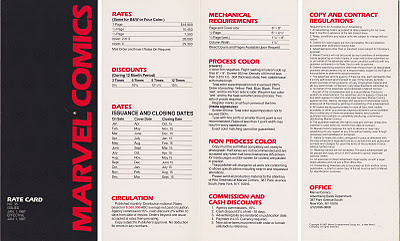 Marvel Rate Card 1987
Marvel Rate Card 1987Click to enlarge
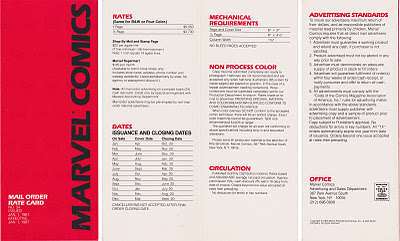 Marvel Mail Order Rate Card 1987
Marvel Mail Order Rate Card 1987NEXT: Fish in a Barrel, for Sure, I promise
Published on November 16, 2011 12:40
November 15, 2011
Comic Book Distribution
In the mid-1960's, Mort Weisinger explained newsstand distribution to me. A publisher contracted with a National Distributor. DC Comics used Independent News, which was owned by the same parent company, National Periodical Publications. Through some strange circumstances I'll explain later, Independent News also was Marvel Comics' distributor.
The National Distributor was like a bank as much as anything else. It financed the creation of the publishers' magazines or comics by paying the publisher an advance based upon the anticipated sales of each issue.
The National Distributor arranged with local distributors to deliver to retail outlets. These local distributors, called Independent Distributor Wholesalers, or "ID's" almost without exception had a monopoly in their city or region. Pittsburgh, for instance had Triangle News. If you bought a magazine or a comic book anywhere in the greater Pittsburgh area, Triangle News had gotten it to the point of sale. The New York area was a large enough market that it had Hudson News, Kable Media, and I don't know, maybe more. At that time, there were, as I recall, more than 500 ID's in the United States and Canada.
The National Distributor set "draws" for each ID, that is, how many copies of each given comic book or magazine would be shipped to them. The total of all the draws, plus copies to be sent to subscribers and office copies comprised the print run for each comic book or magazine. ID's were seldom interested to participate in setting their own draws, and you'll see why in a minute. Except, once in a while, an ID would decide to simply stop carrying comics, therefore making their draws zero, if you call that participating. Only very rarely did any ID's request higher draws on any comic book, as many did with The Life of Pope John Paul II. We even got reorder requests from ID's on that one.
Wise publishers did not accept the National Distributor's draws and set the draws for every title for each ID themselves, based on past sell-through performance. Publishers, who were paying to print and ship those copies were a lot more careful. The idea of "order regulation" was to minimize waste—give each ID as many copies as they were likely to sell and a few besides, just in case the issue got hot for some reason.
The comics, bundled on pallets, were shipped directly to the ID's by the printer (and subscription copies were mailed by the printer). The ID's sorted the comics and delivered by truck a supposedly appropriate number of each issue to each retail account—newsstands, drugstores, supermarkets, what have you. Generally the retailer unbundled the magazines and comics and racked them. Some ID's provided that service.
At the same time the ID's drivers were delivering new issues, they picked up the unsold ones from the previous month, the "returns." The retailer would remove the old stuff and set it aside, or the driver would pick them off the racks. The retailer paid the ID only for the number of copies actually sold. The ID counted up the returns from all the retailers and paid the National Distributor for all copies sold. The National Distributor paid the publisher the difference between the advance and the actual sales revenue. Of course, sometimes, if sales weren't as good as anticipated, the advance was more than the sales, and the publisher owed the National Distributor money. Generally, that was deducted from the next advance.
The reason unsold books were called returns is that, in ancient days, all unsold copies were returned to the publisher intact!
Publishers were free to redistribute their publications to secondary or international markets, offer them through a back issue service, or sell them for pulp.
Things changed.
The cost of shipping the returns back was a burden. Eventually, ID's were allowed to merely tear the covers off and return those as evidence of the number unsold.
Of course, some ID's would then sell some of the coverless books through various lower-tier or bargain outlets, or for paper pulp.
Then, again to save chump change on shipping covers, the ID's were allowed to tear off just the top part of the covers. That actually had the unintended side effect of making the copies marginally more saleable through the less-than-proper outlets.
That's how things were when I started. There was a "general store" in Bethel Park, Pennsylvania, a run-down, old building with that musty old frame building smell, in an area called Coverdale, which I believe had been the company store back when Coverdale was a mining town. They sold coverless and partial cover comics there. That's where I bought Amazing Spider-Man #2, with half a cover for a nickel. I wondered how come that store had comics with half the cover missing until Mort clued me in.
By the mid-seventies, when I started working at Marvel, newsstand distribution had taken another turn for the worse. The distributors were able to force publishers to accept "affidavit returns." No more full copies, no more covers or partial covers. ID's sent in only affidavits that alleged how many copies they'd sold.
So, it worked like this….
Marvel's circulation people would determine how many copies of, say, Fantastic Four Triangle News should draw. Let's say, for the sake of round numbers, V.P. Ed Shukin decided that it should be 10,000 copies. Months later, Triangle News would deliver an affidavit to Marvel's National Distributor, which was Curtis Circulation at that point, swearing that they'd sold 3,000 copies. The accompanying payment would be for 3,000 copies.
Now, let me tell you what really happened. In this hypothetical instance almost certainly, Triangle News received 10,000 copies of a given issue of the FF—the people at the printer, World Color Press, were pretty reliable. Triangle News would have distributed some copies to the retail outlets. A few retailers actually liked carrying comics, but most were indifferent. Comics weren't after all, an absolute necessity to most retailers who sold periodicals, in the way that Cosmopolitan, Playboy, Time and Sports Illustrated were.
So, let's say they actually delivered 5,000 copies to the retailers. If they bothered to deal with unwrapping and sorting, if they had room on the trucks….
Most likely, they'd only actually deliver comics to retailers who would complain if they didn't get comics and places that sold enough comics to make the driver's effort worthwhile.
Let's say the retailers sold 4,000 copies! Pretty good. 80%. 1,000 were returned to the Triangle.
Remember, 5,000 copies of FF never left the warehouse, so then, Triangle had 6,000 copies. No need to deface the comics under the affidavit system. So, they might sell some copies at a discount to bottom-feeder retailers who came around looking for a cheap merch, or shrink-wrap bundles of comics into "bricks," which warehouse clubs like Sam's or Costco would buy. Or they might sell them to secondary or international markets, just as the publishers used to. Or toss them into the paper wolf and sell the pulp.
So, Triangle News might, hypothetically, have sold all 10,000 copies, albeit many at a steep discount and some for pulp.
But they only paid for 3,000.
And that worked so well, why not claim to have sold, and pay for only 2,900 the next month? 2,800 the next month?
So, Marvel's newsstand sales through Triangle looked pretty grim. Under 30%?! Geez, Louise!
I don't remember what the breakevens were like in those days, and I don't have time to dig out the paperwork or do the math, but under 30% was probably below breakeven considering direct costs only, certainly considering contribution to overhead.
If Marvel "regulated" their draw down to try to stop the bleeding, say cutting Triangle back to 7,000 copies, to keep making the same money with their affidavit scam, Triangle would swear to even lower sell-throughs.
Here's a statement of ownership from the very first comic book of mine ever published, Adventure Comics featuring Superboy and the Legion of Super-Heroes #346, on sale around April 1966:
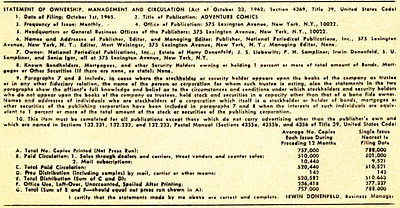 Click to enlargeAverage print run for twelve issues for which final sales information was available, "As of Oct. 1, 1965," it says, was 757,000 copies. Take away the subscription and office copies and the print run, or draw, for distribution through the National Distributor/ID Wholesaler system was, on average, 746,418. Copies sold through that system, on average, 510,000. That's 68.3%. Not bad. And other DC titles, like Superman, did significantly better.
Click to enlargeAverage print run for twelve issues for which final sales information was available, "As of Oct. 1, 1965," it says, was 757,000 copies. Take away the subscription and office copies and the print run, or draw, for distribution through the National Distributor/ID Wholesaler system was, on average, 746,418. Copies sold through that system, on average, 510,000. That's 68.3%. Not bad. And other DC titles, like Superman, did significantly better. I'll provide the documents when I get time to find and scan them, but ballpark, Marvel's sell-throughs via newsstand outlets was in the 40% range when I first started there, but trickled down steadily.
Aha, here's one sales analysis. I'll show more later:
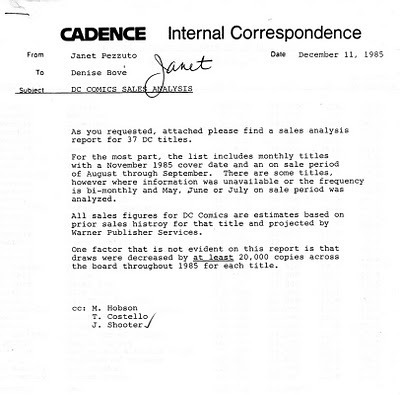
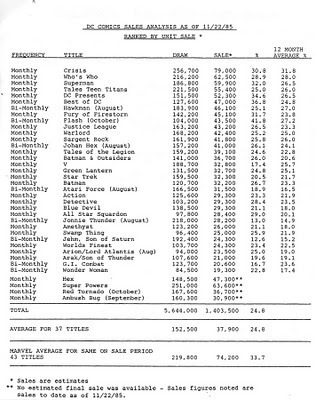
Things were pretty bad for comics in the mid-seventies.
Then the Comic Book Direct Market developed! It saved us, then!
And it's killing us now.
NEXT: Fish in a Barrel
P.S. For those who can't wait to read more about the origins of the Direct Market, Chuck Rozansky has a great account of the early days starting here:
http://www.milehighcomics.com/tales/cbg95.html
Published on November 15, 2011 15:49
November 13, 2011
Designing the Spider-Man Balloon for the Macy's Thanksgiving Day Parade
I was fired by Marvel in April of 1987. Sometime in May, Marvel's business affairs veep, Joe Calamari called me to ask for help.
Marvel's new owners, New World Entertainment (it was New World Pictures when they acquired Marvel, but they'd changed the company name) wanted Marvel to have a balloon and a float in the Macy's Thanksgiving Day Parade. Development of the balloon wasn't going well. He wanted me to consult.
That sounded interesting. And, they were paying me….
I found out that Macy's handles the construction of all balloons and floats. The sponsors contribute ideas or designs and approve the work. The balloon shop, where the prototypes were sculpted was in Jersey City, as I recall. The balloons were actually constructed in Ohio.
So Joe and I drove out to the balloon shop. On the way, Joe explained the situation. The character chosen for the balloon was Spider-Man. Marvel had provided reference to the Macy's balloonatics, but Joe didn't like what they'd come up with. He'd brought John Romita, Sr. in to advise them, but, he said that hadn't helped. His assessment was that John (and comic book artists in general) were okay when it came to two-dimensional drawings, but just couldn't deal with 3-D things, like balloons.
Joe Calamari is a very unusual person. He thinks and does some unusual things. I'll tell you a few stories sometime.
Joe called me because, he said, I was always good with 3-D things, toys and such. All the licensees, for that matter. Okay.
Anyway….
As we were arriving at the balloon studio, Joe said that the Macy's executives had warned him that the sculptor, though a brilliant artist, was "difficult" sometimes because he had a huge ego.
Artist…difficult…huge ego…gee, who ever heard of such a thing?
The balloon sculpture studio was amazing. There were clay sculptures of many past years' balloons all around and several new ones in progress for 1987, among them Ronald McDonald, Snoopy on skates…
…and what appeared to be Spider-Baby in the midst of a strenuous bowel movement.
How can I make the image clearer? Picture Richie Rich:
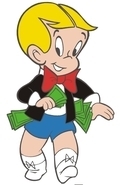 Those proportions.
Those proportions. Position something like this, but more scrunched up, more of a straining-to-poop position:
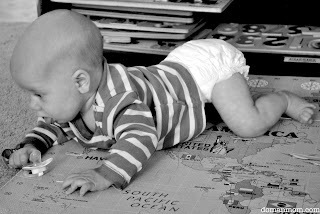 I was introduced to the sculptor. After complimenting the guy on the other sculptures, I told him, as politely as possible, that Spider-Man wasn't quite on spec. How so, he asked.
I was introduced to the sculptor. After complimenting the guy on the other sculptures, I told him, as politely as possible, that Spider-Man wasn't quite on spec. How so, he asked.I started with the proportions.
He flatly dismissed what I said. In patronizing fashion, he explained to me, as if I were as young as Spider-Baby appeared to be, that this was a balloon, you see? It has to work as a balloon. Then he launched into technical talk about "massing" gas cells for lift distribution, aerial stability, blah, blah, blah, blah, BLAH….
Then I got it. It wasn't that John Romita couldn't tell what was wrong with this abomination—it was this:
John is too polite, and very respectful of other artists. John is absurdly honest, and, as honest people often do, assumes the other guy is honest, too, till proven guilty. John is a good and noble soul, reluctant to be cynical and suspicious. And, I suspect, John was uncomfortable arguing technical issues upon which he was no expert with someone, a respected artist, who was.
So…Joe Calamari called in the Bad Cop! Moi.
I said, "Here's what you have to do. First of all, the head is too big. Waaay too big…."
I told the guy firmly that the figure had to have adult proportions. Wider shoulders. Narrower waist and hips. Muscular, but not over-built. I showed him reference (which he already had been given). I demonstrated proper hand position. Foot position. And…you know. Probably everyone who reads this blog would give the guy the same instructions.
Throughout this, the sculptor was fuming. I pressed on.
"This arm forward, this leg back. He has to look like he's crawling!"
"WHAT?!" he yelped. "Absolutely not! I'd have to cut the steel framework!"
"Well, then," I said, "you'll have to cut the framework," while thinking, "There's a steel framework?"
He stridently insisted that what I was describing could not be done. Impossible! It won't fly!
I pointed at Ronald McDonald, who looked like Ronald McDonald and was doing a handstand. "If you can do that, you can do this!"
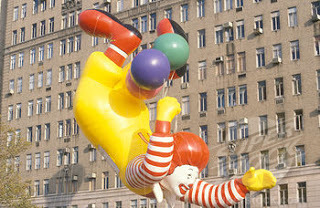 I suspect that John Romita told him more or less the same thing I did, but wasn't willing to be as fiercely obnoxious as I was. What, I should worry that my reputation might suffer? Hah!
I suspect that John Romita told him more or less the same thing I did, but wasn't willing to be as fiercely obnoxious as I was. What, I should worry that my reputation might suffer? Hah!I won.
Later, Joe and I made another trip to the balloon studio to see the model nearly finished. It looked pretty good. Possibly John Romita had done some supervising between my visits, I don't know. Hard to believe the sculptor went from Spider-Baby to a reasonable Spider-Man in one shot, all by himself, but, whatever, he got there.
The sculptor hadn't indicated the webs on the costume yet. I told him not to even attempt it. I asked Joe to have John come back and draw the webs on, and he agreed. And, I guess John did the webs, because they ended up looking right.
The Macy's execs offered me the opportunity to march in the parade as one of the "balloon wranglers" for the Spider-Man balloon. An honor. Doing so, however, would have meant displacing a Macy's employee, to whom balloon wrangling was a big deal. I declined. I wanted to watch, not participate, anyway.
I attended the balloon inflation festivities on West 77th Street on Thanksgiving Eve. It was an amazing feeling watching Spider-Man take shape.
The next morning, the Spider-Man balloon flew just fine, thank you. As it has ever since.
I also consulted with the creation of the Marvel float that year. Float creation was also managed by Macy's. I met with their execs in their offices at the Herald Square store. Someone suggested doing a New York City scene with Marvel Super Heroes. I offered a sketch of the float as a cross-section of the city, showing the sewers and lower levels, Doom's Lab, the street level, Doctor Strange's house and skyscrapers, with heroes and villains each in their proper milieu. I proposed the building that tipped when the Hulk pushed it over. They used my design, and had "extra" characters walking alongside the float.
I'll run my sketch when I come across it.
Fun facts:
In those days, it cost a minimum of $300,000 and $400,000 to have either a balloon or a float created and in the parade, but that bought you an appearance in two years in a row.
While being inflated, the balloons are held down by huge nets.
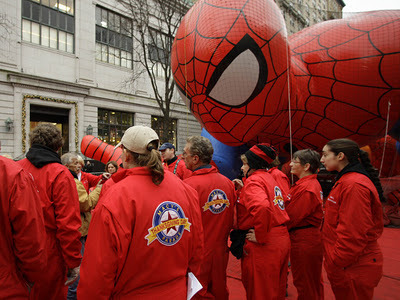 The party that happens every Thanksgiving Eve on the streets on either side of the Museum of Natural History, where the balloons are inflated is awesome.
The party that happens every Thanksgiving Eve on the streets on either side of the Museum of Natural History, where the balloons are inflated is awesome.The floats are built and stored in Jersey and brought to Manhattan in the wee hours through the Lincoln Tunnel.
That was a blast, and I thoroughly enjoyed it. I still love seeing that balloon in the parade.
NEXT: I'm Not Sure – Something Groovy
Published on November 13, 2011 15:22
November 12, 2011
Marvel Cut-Ups
JayJay here. I'm posting one of Jim's answers to a comment as a mini-post since it's kind of fun and about one of everybody's favorite, but least known, Marvel Bullpenners.
czeskleba commented:
A couple people have mentioned the old rumor that Ditko uses his old original art as cutting boards. Most likely that is an urban legend, based on Greg Theakston's misunderstanding of what he saw at Ditko's home. Here's an insightful analysis of the claim by Bob Heer, which credibly debunks it: http://fourrealities.blogspot.com/2008/08/curious-incident-of-cut-artwork.html
The notion that Ditko would do that to his original art is not consistent with what I've read about him. He may not value money that much, or be motivated by it, but he certainly does not have contempt for his own past work.
ANSWER:
I submit this to the "cut-up artwork" speculations: When I worked briefly at Marvel in 1969, I was supposed to be an assistant to Stan -- assistant editor, I guess. What I actually did was anything that needed doing. It was a small group, and everybody pitched in and did whatever was necessary. Therefore, I not only proofread, checked scripts, checked artwork and did "editorial" things, but I did lettering corrections, small pencil and ink corrections (once they found out I had marginal art skills) and...PASTE-UPS.
This was, of course, back in the old rubber cement days before even one coat. I had a little experience doing paste-up, but Morrie Kuramoto taught me Marvel paste-up techniques. What he taught me, I assume, was the standard at Marvel of the day, and since Morrie was the main paste-up guy then, had been the main paste-up guy for a long time, and was still a paste-up guy years later, when I became Editor in Chief, I assume his practices were in effect for a long time. His practices: ANYTIME ANYTHING RAN BEHIND THE ART, MORRIE WOULD CUT THE ART AND SLIDE THE OVERLAPPED THING UNDER THE ART. HE'D FASTEN THE THING THERE WITH TAPE. THIS MEANS THAT IF ART OVERLAPPED A LOGO ON A COVER, IF ART OVERLAPPED A BALLOON IN THE INTERIOR, IF ANYTHING EVER OVERLAPPED ANYTHING, MORRIE WOULD CUT THE ART AND PHYSICALLY OVERLAP WHATEVER IT WAS. WHY? BECAUSE IT WAS THE FASTEST, MOST EFFICIENT WAY TO DO IT, COMIC BOOK PRODUCTION VALUES WERE SO LOW THAT THE CONCEPT OF FLUSH-MOUNT WAS AN ABSURDITY, AND NO ONE, REPEAT, NO ONE GAVE A DAMN ABOUT THE ORIGINAL ART!
A standard joke around Marvel during my time was that the reason Marvel Comics #1 was followed by Marvel Mystery Comics #2 was that Morrie screwed up pasting up the first cover.
Ask JayJay, production expert, about Morrie's shortcuts.
Tell them about floating elements on a pool of rubber cement, Jay. Or the accumulation of stuff peeled from his pick-up.
God, we loved Morrie. He was one of the best men you'd ever want to meet. Paste-up wise, however...let's just say he was old school. Very old school. Like, he pasted up Hammurabi's Code. We called him the "Ancient One." Because he was such a schmoozer, production manager and Morrie's best friend Danny Crespi called him the "Orie-Yenta." Therefore, he was an honorary Jew, therefore Danny also nicknamed him "Moishe." Morrie was amused, and believe me he got his licks in. Those two were a pair.
Everyone who knew Morrie misses him terribly.
JayJay again. It's true, Morrie was really a favorite. I'm not sure how old he was. Old. And fractious. But what a lovable guy. Even people he argued with loved him. Right Rick-o? He was one of those characters that you only see in New York City. He did have very "unique" paste up methods. But effective!
He always had a pocket of his shirt stuffed full of pens and junk and he loved to hang out at the OTB and bet on horse races. He smoked but he also would drink these horrible-tasting healthy raw vegetable juices.
Back in the mid-80's I used to work in the Marvel Bullpen as a designer. I sat near Jack Abel, Jim Salicrup, Kenny Lopez and Morrie. One time when I was very new to Marvel (and to NYC) I was sick for a few days. I was completely unused to being sick and probably whined like a big wuss. So Morrie showed up every morning with a gigantic cup of this awful vegetable juice that he had ordered specially made up for me. I tried to drink it. I really did. I have no idea what was in it. I'm sure it was really good for me and I'm sure it cost plenty, but I'm telling you, it tasted so bad. I got through almost the whole cup the first day, and Morrie kept checking on me! Making sure I drank it! He actually shook his finger at me! I tried pretending to be better but he saw through my act and brought me more the next day.
Oh dear. I tried to drink it again, but I think it tasted worse than the day before! I went to the coffee room for a cup of coffee and nonchalantly put a "to go" lid on it. Some of you may remember, coffee cup lids didn't have little sipping hatches back then so they were really only "to go" and you probably wouldn't normally have a lid on a cup that you were drinking in the office. I brought it back to my desk and after I drank the coffee I placed the empty cup, with lid, on a shelf below my desk. I snuck some of the vile juice into the empty cup when Morrie wasn't looking and kept it covered. I later poured out the juice in the bathroom. I had to do that 3 times! It was a BIG cup of juice. I felt bad, but dang! That juice was going to kill me quicker than the cold.
I think Morrie suspected something or else he got the hint from the faces I made trying to drink the stuff because the third day when he brought in a cup but he had them make it differently. It had some fruit juices in it so it was almost drinkable. I actually suffered through most of that cup with only minor Morrie haranguing. But when he put his feet up for his after-lunch nap I threw out the remains and told him I finished it.
I know. I'm a very bad person. But I was young and foolish. That Morrie, though... what a sweetheart! I do miss him terribly.
czeskleba commented:
A couple people have mentioned the old rumor that Ditko uses his old original art as cutting boards. Most likely that is an urban legend, based on Greg Theakston's misunderstanding of what he saw at Ditko's home. Here's an insightful analysis of the claim by Bob Heer, which credibly debunks it: http://fourrealities.blogspot.com/2008/08/curious-incident-of-cut-artwork.html
The notion that Ditko would do that to his original art is not consistent with what I've read about him. He may not value money that much, or be motivated by it, but he certainly does not have contempt for his own past work.
ANSWER:
I submit this to the "cut-up artwork" speculations: When I worked briefly at Marvel in 1969, I was supposed to be an assistant to Stan -- assistant editor, I guess. What I actually did was anything that needed doing. It was a small group, and everybody pitched in and did whatever was necessary. Therefore, I not only proofread, checked scripts, checked artwork and did "editorial" things, but I did lettering corrections, small pencil and ink corrections (once they found out I had marginal art skills) and...PASTE-UPS.
This was, of course, back in the old rubber cement days before even one coat. I had a little experience doing paste-up, but Morrie Kuramoto taught me Marvel paste-up techniques. What he taught me, I assume, was the standard at Marvel of the day, and since Morrie was the main paste-up guy then, had been the main paste-up guy for a long time, and was still a paste-up guy years later, when I became Editor in Chief, I assume his practices were in effect for a long time. His practices: ANYTIME ANYTHING RAN BEHIND THE ART, MORRIE WOULD CUT THE ART AND SLIDE THE OVERLAPPED THING UNDER THE ART. HE'D FASTEN THE THING THERE WITH TAPE. THIS MEANS THAT IF ART OVERLAPPED A LOGO ON A COVER, IF ART OVERLAPPED A BALLOON IN THE INTERIOR, IF ANYTHING EVER OVERLAPPED ANYTHING, MORRIE WOULD CUT THE ART AND PHYSICALLY OVERLAP WHATEVER IT WAS. WHY? BECAUSE IT WAS THE FASTEST, MOST EFFICIENT WAY TO DO IT, COMIC BOOK PRODUCTION VALUES WERE SO LOW THAT THE CONCEPT OF FLUSH-MOUNT WAS AN ABSURDITY, AND NO ONE, REPEAT, NO ONE GAVE A DAMN ABOUT THE ORIGINAL ART!
A standard joke around Marvel during my time was that the reason Marvel Comics #1 was followed by Marvel Mystery Comics #2 was that Morrie screwed up pasting up the first cover.
Ask JayJay, production expert, about Morrie's shortcuts.
Tell them about floating elements on a pool of rubber cement, Jay. Or the accumulation of stuff peeled from his pick-up.
God, we loved Morrie. He was one of the best men you'd ever want to meet. Paste-up wise, however...let's just say he was old school. Very old school. Like, he pasted up Hammurabi's Code. We called him the "Ancient One." Because he was such a schmoozer, production manager and Morrie's best friend Danny Crespi called him the "Orie-Yenta." Therefore, he was an honorary Jew, therefore Danny also nicknamed him "Moishe." Morrie was amused, and believe me he got his licks in. Those two were a pair.
Everyone who knew Morrie misses him terribly.
JayJay again. It's true, Morrie was really a favorite. I'm not sure how old he was. Old. And fractious. But what a lovable guy. Even people he argued with loved him. Right Rick-o? He was one of those characters that you only see in New York City. He did have very "unique" paste up methods. But effective!
He always had a pocket of his shirt stuffed full of pens and junk and he loved to hang out at the OTB and bet on horse races. He smoked but he also would drink these horrible-tasting healthy raw vegetable juices.
Back in the mid-80's I used to work in the Marvel Bullpen as a designer. I sat near Jack Abel, Jim Salicrup, Kenny Lopez and Morrie. One time when I was very new to Marvel (and to NYC) I was sick for a few days. I was completely unused to being sick and probably whined like a big wuss. So Morrie showed up every morning with a gigantic cup of this awful vegetable juice that he had ordered specially made up for me. I tried to drink it. I really did. I have no idea what was in it. I'm sure it was really good for me and I'm sure it cost plenty, but I'm telling you, it tasted so bad. I got through almost the whole cup the first day, and Morrie kept checking on me! Making sure I drank it! He actually shook his finger at me! I tried pretending to be better but he saw through my act and brought me more the next day.
Oh dear. I tried to drink it again, but I think it tasted worse than the day before! I went to the coffee room for a cup of coffee and nonchalantly put a "to go" lid on it. Some of you may remember, coffee cup lids didn't have little sipping hatches back then so they were really only "to go" and you probably wouldn't normally have a lid on a cup that you were drinking in the office. I brought it back to my desk and after I drank the coffee I placed the empty cup, with lid, on a shelf below my desk. I snuck some of the vile juice into the empty cup when Morrie wasn't looking and kept it covered. I later poured out the juice in the bathroom. I had to do that 3 times! It was a BIG cup of juice. I felt bad, but dang! That juice was going to kill me quicker than the cold.
I think Morrie suspected something or else he got the hint from the faces I made trying to drink the stuff because the third day when he brought in a cup but he had them make it differently. It had some fruit juices in it so it was almost drinkable. I actually suffered through most of that cup with only minor Morrie haranguing. But when he put his feet up for his after-lunch nap I threw out the remains and told him I finished it.
I know. I'm a very bad person. But I was young and foolish. That Morrie, though... what a sweetheart! I do miss him terribly.
Published on November 12, 2011 22:02
November 11, 2011
Ditko at VALIANT and DEFIANT – Part 3
DEFIANT Ditko
In the summer of 1992, days after I was ousted from VALIANT, Frank Miller called me. He said he'd heard what they said. He asked me to tell him what really happened.
Frank was very sympathetic and supportive.
Not too long after that, I got a call from Steve Ditko. The new management at VALIANT had dumped him in a callous and demeaning manner (my characterization of the events, not his). And it sounded like it got to him. He sounded depressed. It must have been one harsh rejection. I'm not going to try to quote him, but for the first and only time to me, he said things about people hating his work. He sounded hurt.
Maybe I read too much into it, maybe I'm coloring it all wrong. Maybe Steve would deny the above. I don't claim to know what was going on in his mind, but that's what it sounded like, that's what it felt like to me.
My turn to be sympathetic and supportive.
Not much I could do to help at that point.
But, after we hung up, I gave Frank a call. At that point, Frank was doing a lot of work with Dark Horse. I said, "I don't know whether Mike Richardson would take my call, but I know he'll take yours." I suggested that Frank call Dark Horse Master and Commander Mike and tell him that right now would be a great time for to do a project with Steve Ditko. I thought it would cheer Steve up considerably to hear from Mike, if there was work to be had.
Frank, a good soul, called Mike. Mike is also a good soul, has abiding respect for Steve and his work and was happy to get a heads up about Steve being available. Mike called Steve. Dark Horse indeed, did something with Steve, although as previously mentioned, Steve is pretty strict about what he'll do and what he won't, so as I recall, it wasn't a very extensive project. But, I suspect it felt good for Steve to get an offer right about then.
The next eight months were pretty ugly. It wasn't enough getting rid of me, the scum who stole VALIANT went for scorched earth. There was a lawsuit. They sued me! Too long to explain here, but it really had to do with establishing a default so that my shares—I owned 25% of the company—would be technically worthless, and therefore could be seized through forced arbitration for nothing! Zero! Giving them the full value of what the shares were really worth.
Meanwhile, the reality was that VALIANT was making $2 million a month pre-tax profit, and they had bids from potential buyers as high as a quarter billion dollars. The greedy pirates wanted it all. They worked hard and played dirty to get it.
I changed my lock at my apartment. I had documents there that proved they had waived all events of default (in order to have a clean balance sheet, necessary for selling the company). Their chief lackey Bob Layton lived in the same building and had a key to the old lock, left over from when he'd showed up on my doorstep with his suitcase and nowhere else to go.
They had ransacked my office, why should I not think they might pay a visit to my apartment when I was away? And steal those damning documents.
I still have the old lock. A souvenir.
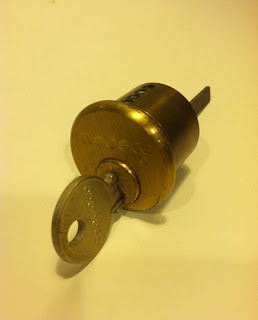 I prevailed in court because I had the documents.
I prevailed in court because I had the documents.But they weren't done. They had just begun to scorch the earth.
Lots more on all that sometime down the road.
I'll tell you this much. They managed to get away with a forced buyout of my shares that paid me less than what I owed my lawyers, not to mention the taxes on same. They eventually sold the company for $65 million in stock to Acclaim Entertainment. Acclaim's stock went up. Therefore, so did the value of the deal, and adding the cash they dividended to themselves before the sale, some tens of millions, the total proceeds to the pirates wound up being well over $160 million.
The man who conducted the sale, Enrique Senior, second in command at boutique investment banking firm Allen and Company, told me that the reason they weren't able to make the sale at the $250 million level contemplated early in the process by big players like Paramount was that "The creative guy was gone."
Another Pyrrhic victory for my collection.
Even though I had been cast out of VALIANT, I had to wait four months, according to my contract, till I was free to start again.
One good thing was that VALIANT was so successful that it wasn't too hard to raise capital again. It's always hard.
As soon as I was legally free to do so, I started laying the groundwork for DEFIANT.
One of the first things I did was meet with Steve Ditko. We met several times and had a number of conversations. One of them, the first DEFIANT related conversation, I believe, took place in the McDonald's in Times Square, near where Steve lives.
I wanted to create, with Steve, a character ideally suited for him.
He wanted a character who wasn't bitten by a radioactive anything, or from another planet, or injected with chemicals. Whatever the character could do that was special, if anything, he wanted to be the result of his own efforts, his own thinking. If empowered, empowered in some novel, creative way by his own mind. And why does it always have to be a young guy? Why not an older man? Steve also didn't want another muscular bodybuilder type. No mansions, no Batmobiles, no costumes. And no "official" super hero name. A real, regular person name—though he allowed that others who didn't know his name might call the guy by some more dramatic appellation.
I started working on ideas.
Meanwhile, DEFIANT was coming together. My little core group met several times in marketing whiz Clark Smith's beautiful apartment on the Upper West Side, laying the business and creative foundations:
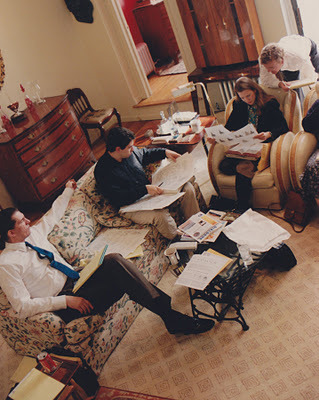 Jim Shooter, David Lapham, Deborah Purcell, Clark Smith
Jim Shooter, David Lapham, Deborah Purcell, Clark Smith
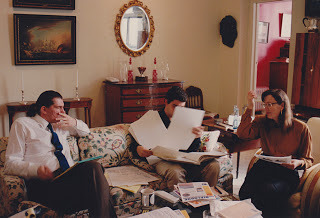 Jim Shooter, David Lapham, JayJay JacksonNotably absent from these particular photos is Chuck Rozanski, Grand Muckety-Muck of the incredible Mile High Comics, who pitched in and helped us tremendously. We couldn't have been DEFIANT without him. Chuck has been a friend for 32 years. Great guy, as honest and honorable as they come. He wouldn't lie to you, about you or for you, no matter who you are.
Jim Shooter, David Lapham, JayJay JacksonNotably absent from these particular photos is Chuck Rozanski, Grand Muckety-Muck of the incredible Mile High Comics, who pitched in and helped us tremendously. We couldn't have been DEFIANT without him. Chuck has been a friend for 32 years. Great guy, as honest and honorable as they come. He wouldn't lie to you, about you or for you, no matter who you are. I had picked the name VALIANT off of a list of suggestions offered me by JayJay. I believe I came up with DEFIANT by myself. Right, Jay?
As for the logo, we sat for a long time trying to come up with an image. I kept making sketches. JayJay kept hating them. She hates everything. Finally, I made a scribbly sketch of a rugged tower that weathered the night and the storm, and as the dawn breaks, still stands strong.
"Give me that!" she snarled. And she made our logo.
 Anyway, I came up with Michael Alexander, custom designed for Steve Ditko. Since "Michael Alexander" didn't seem to be a compelling enough title for the series, I called it Dark Dominion.
Anyway, I came up with Michael Alexander, custom designed for Steve Ditko. Since "Michael Alexander" didn't seem to be a compelling enough title for the series, I called it Dark Dominion.I used the Nine Choirs of Angels as a structural model: 1. Seraphim2. Cherubim3. Thrones4. DOMINIONS5. VIRTUES6. Powers7. Principalities8. Archangels9. Angels
There was never meant to be a direct religious inference, though one of the characters, "Mercy" was fond of quoting the Bible, especially the Book of Job. The idea was that these Angelic Ranks were states attainable by human beings. There also weren't meant to be armies of such people, not even one of each. Very rare.
It was a science fiction take on a Biblical paradigm.
The antagonist, Charles Mal, called Chasm was a "Dominion," and not nice, therefore a "Dark Dominion." Michael Alexander was never in any way labeled as such, but I saw him as a "Virtue," one power level below Mal.
Here are the intros I wrote for them, which appeared on their trading cards:
GLIMMER Michael Alexander#1
Fifty-four year-old Michael Alexander spent a lifetime overcoming the fears that limit human senses. Now he is able to see the Quantum Substratum of reality—the landscape of the Id—underlying the "hard"world. To normal eyes, he is a slight, aging eccentric, but to the evil things of the Substratum he is a mighty power to be feared. They call him Glare or Glint. The good call him The Light, or Glimmer, as in "glimmer of hope." He alone stands between this world and those who would reshape it into a Dark Dominion.
CHASM Charles Mal#33
Charles Mal gained the ability to see the Quantum Substratum of reality through the use of dangerous, illicit, experimental drugs while in college; eventually, he also learned to walk the Quantum Plane. He has used his abilities to make himself rich and powerful. Now he seeks to turn New York City into his private Dark Dominion.
The atmosphere of fear generated by Mal and his lackeys gave rise to a horrific quantum plane "Growth," fear itself, manifested as a vast, tree-like thing overspreading the city.
I invented a vast menagerie of quantum creatures that were manifestations caused by the effect of human minds on the quantum plane, which slowly develop into causes more than symptoms, as well as places and items:
DARK DOMINION
DARK DOMINION DETAILS
1. FLOWERS OF FEAR Hideous, noisome blossoms of the Growth.
2. ID WORMS Offspring of chills that run up your spine.
3. MICHAEL ALEXANDER'S JOURNAL The diary of Glimmer's war.
4. MURKLURKS Quantum things that haunt dark places.
5. MERCY'S ATM FOYER Home to Glimmer's confidant.
6. DARK POWER Chasm "speaks fire" and burns Quantum enemies.
7. SLOTHSLUGS They mire the lazy in viscous Quantum mucus.
8. SPIDERS OF ANXIETYBorn of gnawing concern, they scuttle along the edges of perception, weaving webs of dread.
9. EAST RIVER HORRORS Kin to Murklurks, they grow from the special fear of watery death.
10. SKINNER'S LAIR A shrine to implements of pain and death.
11. RAGE-IRKS Spastic, indescriminate destroyers born of irrational anger.
12. LEEREYES Paranoia-born starers that make your skin crawl.
13. BLUSTERRUBS Abrasive pride-spawn.
14. GNAWERS They chew and suck on the fixated.
15. WISPS Quantum authors of sudden chills.
16. SNITPICKS Envy-born Quantum shrews.
17. PITKNIVES Eviscerating stabbers bred by emotional trauma.
18. SLYMOOZE Unctuous, putrid run-off from defilers and their victims.
19. KNUCKERS Vicious Quantum eggers-on spawned in hordes by batterers.
20. DARKLAFFS The things that go bump in the night.
21. SUCKBATSDark Quantum creatures of the sky that flit menacingly on the fringe of awareness.
22. CURSHADOWS Vicious Quantum hell-hounds lurking in the dark.
23. BLOATOADSThe offspring of gluttony, they flit across reflective surfaces, not quite seen.
24. PSYCHOPATHETICS Vile, chaotic, irredeemable taunters of the deranged.
25. PLAGUERS The spawn of forbidden temptations.
26. SCATHES Stinging, scratching punishers of mistakes and failings.
27. SCUNGERS Id-made grabbers you allow to drag you into depravity.
28. BEATERS Born of guilt, they flog you.
29. CREAKERS Haunters of ancient places.
30. PSYCHOTODES Squirming, virulent brain-worms.
31. SCABBERS Quantum builders of crusty, ugly psychological shells.
32. REEKERSThey revel in foulness, wallow in filth, and thrive in Slymooze.
33. SCUMMERS Given form by defilers, they plague guilt-ridden, debased victims.
34. BITERS Dagger-toothed Quantum things that inflict painful pangs of doubt.
35. HIDEPEELERSQuantum torturers made manifest by self-loathing; the pain they cause is like being flayed alive.
36. SNAKERS They coil around and constrict your will.
37. MITES OF INFERIORITY They tickle and itch your flaws, eroding self-esteem.
38. SEXUALLICEKin to Mites of Inferiority, they bite and suck away sexual self-confidence.
39. NEEDLESKEETERS Piercers of the sense of purpose, feeders on the will.
40. HEARTRASPS Quantum torturers of unrequited lovers.
46. HUMILITANTS Nettle-like Quantum scourges of those who deem themselves inadequate.
42. HEATWRATHS Searing Quantum igniters of mass violence.
43. LOATHORNS Thorny briars cultivated by long-term hate.
44. NIMRODS Quantum-spawn of excessive ego.
45. NIGHTBITES Mysterious nocturnal biters and stingers made manifest by the id.
46. SQUATTERS Other peoples' id-wrought blights that they shift onto you.
Plus a cast of dozens.
After negotiating with a slew of potential investors interested in funding DEFIANT, it came down to two candidates. Patricof & Co. and the River Group. I ultimately went with the River Group. The deal was finalized at the offices of McFarland Dewey and Co., the investment banking firm representing me, while their 1992 office Christmas party was going on just outside the room we were in.
Should have gone with Patricof. Big mistake going with the River Group. But that's a story for later.
The River Group owned a trading card company, so the first issue of Dark Dominion, #0, was done as a trading card set that could be assembled in an album into a comic book. I wrote it. The script is available for download in the sidebar.
Steve Ditko drew it. Or he started to.
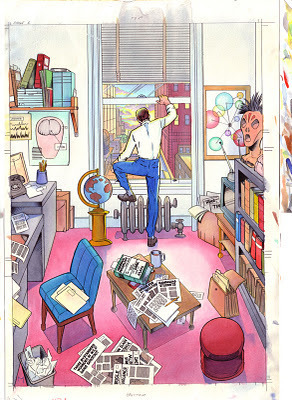 A scan of the original painted color art. I know I've told this tale before, but….
A scan of the original painted color art. I know I've told this tale before, but….Halfway through the book, Steve came to the office to see me. He gave me the pages he'd done and said he couldn't do the rest of the story.
"Why not?!'
Because, he said, the story and the character were Platonic and he was Aristotelian.
"You're gonna have to explain that to me, Steve."
Simple. Plato believed in the world one can't see as well as the world one can. Aristotle believed that what you see is what you get. Period. Dark Dominion was Platonic, and therefore, anathema.
I argued. You can't see viruses, I said, but they can make you sick. And what about all the other things invisible and unknown to Aristotle that have since been discovered?
He wouldn't budge.
I did get him to agree not to leave me high and dry on #0, after we'd already solicited it, after we'd advertised the fact that he was doing it.
He reluctantly agreed to finish the book.
Steve didn't do any more work for DEFIANT after that. Not because there were any hard feelings either way, mind you. He had plenty of offers around that time and we didn't really have much that interested him.
We remained, and remain friends.
OVER THE WEEKEND: Designing the Spider-Man Balloon for the Macy's Thanksgiving Day Parade
NEXT: I'm Not Sure – Check Back Later
P.S. Today is Veteran's Day. In the Preface of Breakfast of Champions, Kurt Vonnegut, Jr. said this about this day:
"…So this book is a sidewalk strewn with junk, trash which I throw over my shoulders as I travel in time back to November eleventh, nineteen hundred and twenty-two.
I will come to a time in my backwards trip when November eleventh, accidentally my birthday, was a sacred day called Armistice Day. When I was a boy, and when Dwayne Hoover was a boy, all the people of all the nations which had fought in the First World War were silent during the eleventh minute of the eleventh hour of Armistice Day, which was the eleventh day of the eleventh month.
It was during that minute in nineteen hundred and eighteen, that millions upon millions of human beings stopped butchering one another. I have talked to old men who were on battlefields during that minute. They have told me in one way or another that the sudden silence was the Voice of God. So we still have among us some men who can remember when God spoke clearly to mankind.
Armistice Day has become Veterans' Day. Armistice Day was sacred. Veterans' Day is not.
So I will throw Veterans' Day over my shoulder. Armistice Day I will keep. I don't want to throw away any sacred things.
What else is sacred? Oh, Romeo and Juliet, for instance.
And all music is."
He got through to me, for sure. He's right. We should cherish sacred things. I kept silent and still for the eleventh minute of the eleventh hour today.
May you be well.
Published on November 11, 2011 14:12
November 9, 2011
Ditko at VALIANT and DEFIANT – Part 2
First This
JayJay the obstreperous Blog Elf yelled at me for not including a more personal story involving Steve Ditko Monday.
You know what? That's just what I need in my life, more people yelling at me.
Here's a picture of JayJay. She's the mean-looking one at the bottom:
 Anyway….
Anyway….Here's a Ditko at Marvel story that requires a set up.
Another "First Meeting" story
Bob Kanigher. In all my visits to DC's offices from the mid-1960's through the mid-1980's, I never officially met Bob Kanigher. I walked past his office once, the door was open and he was in there. Whoever was with me, probably Mort Weisinger or E. Nelson Bridwell said, "That's Bob Kanigher," but he never even looked up from what he was doing.
I don't remember which year, 1986, I think, DC Comics cut Kanigher loose. Thanks for everything, now, get out.
Shortly thereafter, Kanigher called me. He said he had written something, not a comic, a piece for some magazine or other that used me as a character. He told me he wasn't asking for permission to use me, and frankly didn't care whether I liked it or not. However, as a courtesy, he would come up to my office at Marvel and show it to me.
I told him it that wasn't necessary. If it was a done deal, why bother? I'd probably see it at some point anyway. But I thanked him for the offer.
I don't think that was what he was expecting to hear. He persisted, trying to pique my curiosity. He practically insisted that I had to see this thing. Finally, I got the feeling that he just wanted to come to Marvel and talk. That figured. He needed or wanted work. Well, why not just say so? Whatever. I said he was welcome to stop by.
Later, the receptionist called and said Bob Kanigher was here to see me. I went out to fetch him myself, which felt properly respectful. Kanigher was a giant. Figuratively speaking. Actually, he was a little guy.
And I am huge. Looming over him, I shook his hand. Can't help but loom when he's Jack and you're the beanstalk. I walked him back to my office.
One of my guest chairs had been pushed up too close to the desk, so I pulled it out to its normal position. Kanigher paused at the "indicated" chair, then made a show of going around it to the other chair.
Oh, good grief. Now, it started to make sense. He'd obviously read some business psychology book or three. Don't ask for a meeting, manipulate them into asking you. Stay in command by refusing the chair offered and choose your own. Etc. Art of Japanese Management stuff.
Jenette Kahn was into that stuff too, periodically taking the DC staff on retreats, making them all get up early and do calisthenics together. Paul Levitz absolutely refused to attend the calisthenics sessions, so he said.
Anyway….
Kanigher and I sat down. I'm still towering, even sitting. I was still looking down at Kanigher. He sat for only a second, then stood and leaned forward his hands on my desk, so he could look down at me. Sigh.
The piece he'd written, by the way, had a character with the last name "Gun," and it didn't seem to have much to do with me. I thanked him for showing it to me.
Kanigher started talking, telling stories starring him. All about his triumphs of various kinds, not just in the comics field. About artwork of his that hung in museums around the world, including the Louvre. About a time in Italy when an exquisitely beautiful young woman on her wedding day saw him through the window as he passed by and had to have sex with him, right then! And the time a limo pulled up beside him on a New York street and the fabulous, famous woman in the back begged him to have a wild, wanton romp with her. And other romantic conquests. How he had browbeaten the people at Burberry into honoring the lifetime guarantee on his trench coat, though he had admittedly ruined it through abuse. About big time politicians and leaders who sought his counsel. More.
This went on for a while. I knew what he was doing—the "don't ask for anything, make your wonderfulness clear so they'll make you an offer" routine. Sigh. I guess I could have cut him off at any point and asked him if he was looking for writing work. But, A) it was fascinating in a surreal sort of way, and B) something ornery in me didn't want to allow myself to appear to have fallen for biz psych 101 tricks.
I slowly slumped lower and lower in my chair. Till my chin was almost at desktop level. The better to accommodate his looking down on me.
Finally, he started talking about all the brilliant ideas he had and all the offers he had. How he was going to revolutionize not only the comic book business, but the entire entertainment industry.
So I said, "That's great, Bob. Good luck with everything."
He seemed to be in pain. I guess I would be too, standing and leaning on a desk for hours, trying to loom over someone. But then again, I don't really have to try to loom.
Finally, desperate, I guess, he didn't quite ask for work, but he mumbled something about deigning to grace us with a few scripts.
So I called Larry Hama and told him Kanigher was in my office. Maybe he'd like to talk with him? Larry came right away. He seemed happy to see Kanigher and the two of them went off to Larry's office to talk about possible work.
Clash of the Titans
I don't know what, if anything Kanigher did for Marvel. That was pretty close to the end of my tenure as Editor in Chief. I was so busy battling with the Cadence Management Inc. jerks who had taken Marvel private and were screwing over the creative people (and everyone else) that I was pretty much out of touch with what was going on in the comics.
He must have been cooking up something with Larry, though, because I'd see him around the office now and then.
At some point Kanigher gave me a stack of plots for various Marvel characters. Captain America, the Fantastic Four, others. Nothing revolutionary, but good solid stories, as you'd expect. I was gone soon thereafter, so nothing came of them that I know of. I might summarize one or more of them here one day, if anyone's interested.
One day, at the end of the day, Steve Ditko was in the office, probably delivering an issue of ROM. Bob Kanigher and Steve Ditko ran into each other in the hall. Somebody, probably Larry Hama, introduced them. I guess in all their years they'd never met, or maybe it had just been a long time. They started chatting.
On his visits to the office, Steve would never even have a cup of coffee before he accomplished whatever was the purpose of the trip. "Production before consumption," he'd say. But once the "production" was done, he often hung around and talked with people, the kids, the vets, the old timers, he didn't care. Anyone who thinks he's totally a lone wolf, nah, no way. He seemed to like being around us. He tolerated our cast of crazies, including me, pretty well, I think. And as far as I know, everyone treated him with great respect.
Anyway, the meeting between Ditko and Kanigher took place right outside my office, and my door was open, as it always was, and I was working late, as I pretty much always did.
After a few moments of more general chitchat, something Kanigher said strayed into liberal philosophy. Steve immediately challenged the statement.
And, they're off…!
Those two stood there for hours arguing. In gentlemanly fashion, mind you, but fiercely nonetheless. Kanigher was…hmm…I guess it's okay to say he was a liberal. An intellectual progressive, maybe? Whatever. Don't make too much of that assessment. I don't mean to label the guy. The point is that his position was miles away from Steve's.
Which is not to label Steve a conservative or anything else.
I wouldn't attempt to categorize Steve's point of view. I will say that I do not believe he conveniently fits in any box. He is a very, very smart man and whatever his sources of inspiration, he is, I believe, his own man. Unique. Enough things he has said have been brought up in the comments here during the last three days that one can get a sense, directionally, of his philosophies. Maybe.
One thing about Steve, he has done his research and done his thinking and has clearly argued his points many times. He enters every discussion loaded for bear.
All right, here's another unschooled observer's characterization of Kanigher's philosophy. He was arguing what he felt was common sense. Everybody knows blah, blah, blah….
Steve did not accept whatever was offered as "common sense," and, well-prepared, had answers for everything.
Example: Kanigher referenced the public's right to know. Steve challenged that. Where in the Constitution is the "right to know?" How is it any of the public's damn business what happened in non-public circumstances?
Eminent domain came up, too. Kanigher argued for the greater good. Steve argued for the rights of the owners of property.
Steve, with his massive arsenal of pre-loaded arguments had Kanigher on the defensive and reeling. But Kanigher went into rope-a-dope mode and stubbornly kept punching. The Rumble in the Jungle should have been this good.
No winner. Though, truly, I could have listened to them all night, it was that fascinating, finally I needed to go home. I came out of my office and started injecting exit ops, "You two will never agree." "Nothing's going to be settled here tonight." Etc. Eventually, they got the hint and we got on the freight elevator, went out the back exit and on our separate ways.
I suspect Steve felt like he won every point, and I suspect Kanigher chalked it up as another conquest.
There was another such debate once. In Ann Nocenti's office, after hours, Ann, Chris Claremont, a couple of other people I'll dare to allege are liberals got into it with Steve. It went similarly, I think. Chris or Ann can tell that story better, I was just a passer-by.
Old Timer's Day at VALIANT A 3-D Special!
VALIANT had an eclectic mix of people. We had kids right out of the Kubert School, kids off the street, like David Lapham. Guys and girls who were getting their first pro work. We needed them and they had no other options.
We had a few people who, for various reasons, had no place else to go, like Bob Layton, Barry Windsor-Smith and me.
And some old guys nobody else wanted. We had Don Perlin, an old guy who became someone nobody else wanted when he left Marvel to come and work for me. He hated Marvel at that point and liked me. Go figure. But coming to work for The Great Satan meant being blackballed everywhere else.
We also had John Dixon, an old guy from Australia, I think. Great artist. No takers, except me. He just wasn't hip enough.
Then there was Stan Drake. Old guy. Little known fact, he shared a studio in Connecticut with Bill Sienkiewicz. Stan Drake. One of the all-time greats. An inspiration to Neal Adams. A genius. Working long after he should have been retired to pay a prodigious amount of alimony.
Did you know he ghosted Blondie for Chic Young? The guy could do anything.
And we had Steve Ditko. The co-creator of Spider-Man who was no longer welcome at the House of His Ideas.
So the nobody-else-wants-us band at VALIANT was eclectic to say the least.
Because we had so many old dudes, we decided late one evening, in the delirium that lack of sleep brings, to have an Old Timers Day Party.
VALIANT didn't have any money. I didn't have any money. But, by virtue of having been pretty prosperous during the last few years I'd been EIC of Marvel, I had some credit cards with biiig limits.
So, we set a date, secretary/managing editor/office manager/slave driver Debbie Fix arranged for a catered lunch and we invited all people VALIANT.
Stan Drake said he couldn't come. He couldn't afford to lose the work time, that's how oppressive his obligations were.
I asked him, do you take time for lunch? Yes. Well, how about if I hire a chauffeured car to pick you up at your studio, drive you to our office on Seventh Avenue in Manhattan? You have lunch with us, and the car will be standing by outside to whisk you back to work. Minimum time lost.
He agreed. Thank God for credit cards.
So, it happened.
My mother, Eleanor Shooter, was visiting from Pittsburgh. When she came to visit, she liked to come to the office and help out. She enjoyed being the receptionist. Go figure.
Anyway, Stan Drake arrived. He flirted with my mother! Quite the ladies' man. No wonder he was in alimony Hell.
Anyway….
The three D's got to meet each other at last, Drake, Dixon and Ditko. And the fourth D, Don Perlin, of course, and Richard Rockwell, nephew of Norman Rockwell.
Stan Drake was a major influence of John Dixon's as well as Neal's. Richard Rockwell had been Milt Caniff's assistant, and Dixon, who loved to draw aircraft and did an aircraft-intensive strip in Australia, was in a way that continent's answer to Caniff. Perlin had worked with Eisner, was very accomplished in comics and had many tales to tell. Ditko, of course, everybody held in high regard. The stories of old days flew thick and fast.
And we all had lunch. Anything Debbie organized was perfect, as was this event.
I was very proud of the young guys, who all treated the old guys with great respect. Hung on their every word Honored them.
Steve wouldn't let us take his picture, but here are some other pix.
 John Dixon, Don Perlin and Stan Drake hamming it up.
John Dixon, Don Perlin and Stan Drake hamming it up.
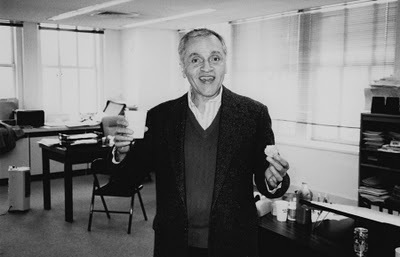 Old guy Jim forgot to mention that the inimitable Ernie Colón was there, too. - JayJay
Old guy Jim forgot to mention that the inimitable Ernie Colón was there, too. - JayJayPS. That's Jim's desk in the far background with a folding chair for guests.
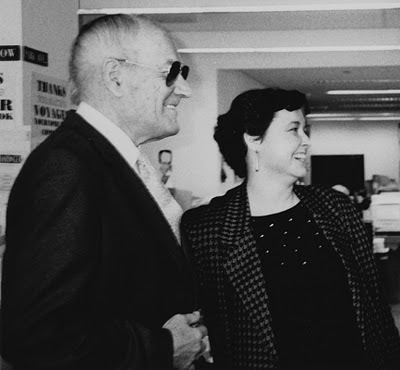 The fabulous Debbie Fix yukking it up with Dashing Stan Drake.
The fabulous Debbie Fix yukking it up with Dashing Stan Drake.
 John Dixon, Don Perlin, Jim Shooter, Stan Drake, Bob LaytonStan had to go too soon.
John Dixon, Don Perlin, Jim Shooter, Stan Drake, Bob LaytonStan had to go too soon.But, Geez, Louise, that was a dream day!
NEXT: DEFIANT Ditko!
Published on November 09, 2011 16:11
November 7, 2011
Ditko at VALIANT and DEFIANT – Part 1
I first met Steve Ditko sometime in 1977. For the life of me, I can't remember where.
It might have been at Continuity, Neal Adams' studio. Continuity was the crossroads of the comics industry. Besides the people who actually worked there, a lot of artists would show up looking for freelance advertising or storyboard jobs, which paid way better than comics. Some comics creators—Cary Bates, Jack Abel and Howard Chaykin come to mind—sublet studio or office space from Neal. Continuity was a Mecca for young artists. New kids trying to break into the business like Frank Miller and Bill Sienkiewicz would turn up hoping that Neal would look at their samples and give them advice. Other comics people, like me, for instance, would show up once in a while to see someone who worked there, talk business with Neal or just hang around the crossroads for a while and catch up on the industry gossip.
As far as I know, Steve Ditko never worked there, but, like I said, almost everybody stopped by at some point for one reason or another.
Anyway, I met Steve, probably there. What an honor. I loved his work. When I was a kid I tried to emulate his style.
 Drawing by Jim Shooter when he had just turned age 13By the way, Neal was at his crusading best in those days, leading the fight to get Siegel and Shuster recognition and compensation for creating and establishing Superman—and winning. He also was one of the prime movers of the Comic Book Creators Guild. A story about the Guild which includes an anecdote involving Steve Ditko can be found
here
.
Drawing by Jim Shooter when he had just turned age 13By the way, Neal was at his crusading best in those days, leading the fight to get Siegel and Shuster recognition and compensation for creating and establishing Superman—and winning. He also was one of the prime movers of the Comic Book Creators Guild. A story about the Guild which includes an anecdote involving Steve Ditko can be found
here
. After I became Editor in Chief of Marvel in 1978 and therefore had the power to offer him work, I told Steve that if he ever wished to work for Marvel he was welcome. Anytime. He was a Founding Father. I couldn't rectify all the past injustices (though I was trying), but I could and would keep our door always open to him.
Steve apparently wasn't too keen on having anything to do with Marvel early on, but a few years later, he came to see me at Marvel's 387 Park Avenue South offices. I think he realized that we had made a sincere effort to make things better and deal more fairly with creators. Or maybe the fact that Stan wasn't there any more (having moved out to the Coast to work at Marvel Productions) made a difference. Or maybe he just wanted work. Whatever. He was willing to work for us and I was happy.
Giving Steve work is easier said than done. He's very particular about what he will and won't do. He wouldn't consider anything to do with Spider-Man or Doctor Strange, for instance. He refused to work on any books with "flawed" heroes. He had a pretty strict definition of "hero." Per him, the character isn't a hero if he or she is flawed.
I said, but what about Spider-Man? Wasn't he flawed? Steve said that when he worked on Spider-Man, Spider-Man wasn't yet an adult. It was okay for a kid to make some mistakes, but….
Okay.
Fortunately, we had ROM, Spaceknight. ROM fit Steve's criteria well enough. He did some great work on ROM.
But if we hadn't had ROM, we would have created a character for Steve that suited him. As long as I was EIC, there was a place for him at Marvel, even if we had to make one up special.
I left Marvel in April of 1987.
In November 1989, I started a company called Voyager Communications Inc. No comma before "Inc." Just like Time Inc. Voyager published comics under the VALIANT imprint. VALIANT (my VALIANT) is all caps, always.
I had acquired the rights and set out to publish new adventures of Magnus Robot Fighter, Solar: Man of the Atom, Turok Son of Stone and other old, then-dormant Dell/Gold Key characters.
But I lost control of the company shortly after we started. On Friday, December 22nd, the last working day before Christmas, I was walking home from the office at Seventh and 47th. I lived on Madison at 38th. Partner Steve Massarsky was with me, headed for Grand Central. We walked together as far as 44th and Madison. There, on that corner, he told me he had been secretly dating and was sleeping with Melanie Okun, one of the two principals of Triumph Capital, the venture capital firm that had funded Voyager.
Merry Christmas.
I told my other partner, Winston Fowlkes. Like me, he was appalled. Talk about a conflict of interest…!
After the holidays, Winston protested to Melanie's partner, Michael Nugent. Winston insisted that something be done.
Something was done, all right. Massarsky, his bedmate and her partner convened the board and fired Winston for daring to object. Massarsky's shares and those controlled by Michael and Melanie/Triumph constituted a majority. I was President of the company, but they had ultimate control.
So, my plans to do super hero books were shelved. Massarsky had other plans.
Massarsky had been supposed to wind down his entertainment law practice and work full time for Voyager, but he didn't. He increased his practice, in fact. Even hired an associate. He worked nearly full time on his own business, screw us, though he still drew a salary from the comics company. Used our space. Ran his mail through our postage meter. Used our supplies. Etc. Nothing I could do about it. His bedmate and her partner allowed it. They had me outvoted.
Massarsky became the entertainment lawyer for Nintendo and also took Leisure Concepts International as a client. LCI represented Nintendo for licensing as well as the World Wrestling Federation. So, he did a little self-dealing, licensing first Nintendo for comics, then the WWF for comics. Those deals he made with himself profited him, personally. A lot. And I was stuck with having to create Nintendo and WWF comics.
Why not quit? Easier said than done. Lots of reasons I'll explain sometime later.
Besides, all the bad guys wanted was money. I believed that if I could somehow make the company succeed, I could raise the money to buy them out. Fulfill their "exit strategy." That's what Triumph and Massarsky wanted—the big killing and exit.
So, we were making Nintendo and WWF comics. An interesting (to me) tidbit is that David Lapham's first professional comics work was for one of our WWF books.
Then one day, Steve Ditko came to see me.
I don't know exactly how long Marvel had kept Steve on after I left there, but eventually they'd cut him loose. Jerks.
I'd never before seen Steve looking…I don't know. Worn down? Worried? Troubled? Hard to say, Steve doesn't exactly show his feelings much, and was not the type to express despair or even its lesser cousins. But he didn't look happy. He didn't look well. And he needed work.
I didn't have the power to make something to suit him, and believe me, Steve is the kind who would starve rather than violate his principles, but luckily, I had WWF scripts waiting to be drawn! The WWF "faces" (short for babyfaces, good guys) were good enough and the "heels," or bad guys, were evil enough to pass muster with Steve. I think that was the one time I was happy that we had the WWF.
He started working for us.
He may not have been a Founding Father of VALIANT, but as far as I'm concerned, his Founding Father card should be honored everywhere in this business.
P.S. He did some great stuff for us.
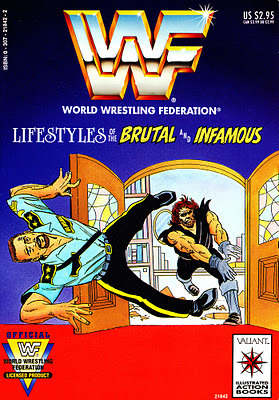
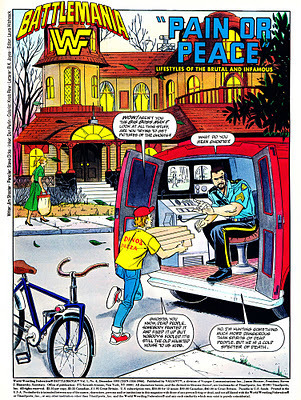



NEXT: A 3-D Special! Old Timer's Day at VALIANT
Published on November 07, 2011 14:14
November 6, 2011
Thanksgiving in Newark
David Michelinie's check didn't come. It was the Wednesday before Thanksgiving, 1978, I think.
Marvel Comics was still sorting out its payment procedures, which went through several changes during the first year I was Editor in Chief. You can read about it here and here .
The deal was supposed to be if your voucher was received by the cutoff day one week, your check would be mailed Monday of the next week. By Wednesday, surely, you'd have your check.
But, no.
Dave lived in Newark, Delaware. He called me at the office that Wednesday to…umm…gently express his…umm…disappointment? What's the politest way to say murderous rage?
Most of us lived hand to mouth in those days. The business was struggling. Most of us were struggling. Dave was more responsible than most. A solid citizen. He owned a home. He managed pretty well, compared to some of us.
But he needed that check. It was the day before Thanksgiving. He had no cash and hadn't been to the grocery store lately. What was he supposed to do, eat cat food for Turkey Day?
I looked into it. Somehow his voucher hadn't made it into last week's batch. Bookkeeping had put it aside because of some question about it.
Great.
I went upstairs and calmly, rationally, at the top of my lungs convinced the money tweezers to cut that check. Right now would be lovely.
I called Dave back and told him I would hand deliver the check the next day, Thanksgiving. So what, he said. His bank would be closed. I told him the ol' expense account would buy us dinner, and I'd bring him some cash.
I lived in Queens Village at the time, and I had a car. A car was a necessity out that way and the apartment complex had a parking lot, which is Heaven on Earth in the New York area.
The next morning, I drove to Newark, about 150 miles away. It took four hours or so. I don't think Dave believed I was coming until I showed up on his doorstep. With a check and American money in hand.
I got to see his place. Very nice, made all the more charming by the extensive collection of nunchakas hung from the living room ceiling. I got to meet his cat, a gray shorthair, I think, named "Mouse." Mouse? I can't complain too much about that. I've got a cat named "Tomato."
For dinner, we went to one of the few joints nearby that was open, a sort of upscale pub. Very nice, actually. I don't think we had turkey. I don't think they served turkey. I believe we ate excellent burgers. Close enough.
I went home after dinner. There had been a little traffic on the way down—people on their way to grandma's house, I guess—but almost none on the way back while everyone else but me was slumped in front of the football game on the tube in a tryptophan-induced stupor. It took less than three hours.
So, I set right a Marvel mistake. I had a good meal. Dave and I were both Turkey Day "orphans," in the sense that neither of us had any family or folks anywhere close, so it was good to have company. All in all, it was a pretty good Thanksgiving.
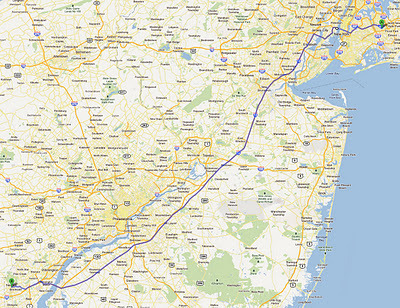 This is the route from Queens Village to Newark, Delaware.
This is the route from Queens Village to Newark, Delaware.MONDAY: Ditko at VALIANT and DEFIANT
Published on November 06, 2011 14:15
November 5, 2011
A Question About Writing for Television and Movies
QUESTION:
ANSWER:
Writing for television means adhering to many strictures and limitations -- things like building in a hook before each commercial break, obligations to performing talent, sticking strictly to the bible and staying within strict conceptual parameters. And more. The money is bigger, the stakes are higher. Therefore: There is very little tolerance for inflated egos and self-indulgent prima donnas. The supervision is rigorous and exacting. The people who write TV, almost without exception, know their craft and are skilled professionals. For most shows that accept pitches you have to be qualified and approved before you're even allowed to pitch.
All of that said, there are, of course, some writers who work brilliantly under those tight conditions and do great things, some who do impeccably structured, uninspired crap and many who fall in the middle. Knowing all the steps does not make one a great dancer, but at least TV writers in general know the steps.
So do film writers. The competition there is so fierce that unskilled writers fall by the wayside or, at best, sell a draft for the ideas in it, which is summarily rewritten by someone with skills. The problem with movies is that too often good scripts are weakened downstream by directors, producers, studios. The well-written screenplay for Dragonslayer, for instance, was eviscerated by studio execs who thought many more minutes of "action," i.e., a rubber dragon flapping around would be "more commercial" than a solid story. Even William Goldman has many such horror stories.
The comic book industry is rife with writers who do not know writing basics, the sort of things Mark Twain cites in his "Nineteen Rules." Supervision is usually lax and the supervisors often are clueless. So, there is more "freedom" in the sense that some can get away with more self-indulgent, amateurish garbage; and some who don't have basic skills are allowed to fumble their way along blindly. It seems that the only skills the creative management at the two major companies require of writers are a knack for glib patter and "events," or gimmicks. In an earlier comment, Marc Miyake hit the nail squarely -- they seem to focus on STIMULI, not story. What's the most shocking thing we can do? Break Batman's back! Kill Thor! Make Hal Jordan a villain! Then throw it all away and start over with Ultimate or New 52 so there are new opportunities for shocking stimuli. That seems to be all the companies care about.
And P.S., too many artists these days can't tell a story even if given a good one. But, they're given carte blanche, as long as they've got some dazzle.
Seems to me that's a good way to kill an industry.
All of that said, there are some writers who actually do have a clue and do some brilliant work. Too many do work that is craft-less, clueless uninspired crap or mediocre at best.
Dear Jim,
I hope this isn't a silly question, but what differences do you see between comics writing and writing for TV or movies? Would you say that comic book story structure is less rigid and formulaic?
Pete Marco
ANSWER:
Writing for television means adhering to many strictures and limitations -- things like building in a hook before each commercial break, obligations to performing talent, sticking strictly to the bible and staying within strict conceptual parameters. And more. The money is bigger, the stakes are higher. Therefore: There is very little tolerance for inflated egos and self-indulgent prima donnas. The supervision is rigorous and exacting. The people who write TV, almost without exception, know their craft and are skilled professionals. For most shows that accept pitches you have to be qualified and approved before you're even allowed to pitch.
All of that said, there are, of course, some writers who work brilliantly under those tight conditions and do great things, some who do impeccably structured, uninspired crap and many who fall in the middle. Knowing all the steps does not make one a great dancer, but at least TV writers in general know the steps.
So do film writers. The competition there is so fierce that unskilled writers fall by the wayside or, at best, sell a draft for the ideas in it, which is summarily rewritten by someone with skills. The problem with movies is that too often good scripts are weakened downstream by directors, producers, studios. The well-written screenplay for Dragonslayer, for instance, was eviscerated by studio execs who thought many more minutes of "action," i.e., a rubber dragon flapping around would be "more commercial" than a solid story. Even William Goldman has many such horror stories.
The comic book industry is rife with writers who do not know writing basics, the sort of things Mark Twain cites in his "Nineteen Rules." Supervision is usually lax and the supervisors often are clueless. So, there is more "freedom" in the sense that some can get away with more self-indulgent, amateurish garbage; and some who don't have basic skills are allowed to fumble their way along blindly. It seems that the only skills the creative management at the two major companies require of writers are a knack for glib patter and "events," or gimmicks. In an earlier comment, Marc Miyake hit the nail squarely -- they seem to focus on STIMULI, not story. What's the most shocking thing we can do? Break Batman's back! Kill Thor! Make Hal Jordan a villain! Then throw it all away and start over with Ultimate or New 52 so there are new opportunities for shocking stimuli. That seems to be all the companies care about.
And P.S., too many artists these days can't tell a story even if given a good one. But, they're given carte blanche, as long as they've got some dazzle.
Seems to me that's a good way to kill an industry.
All of that said, there are some writers who actually do have a clue and do some brilliant work. Too many do work that is craft-less, clueless uninspired crap or mediocre at best.
Published on November 05, 2011 12:39
Jim Shooter's Blog
- Jim Shooter's profile
- 85 followers
Jim Shooter isn't a Goodreads Author
(yet),
but they
do have a blog,
so here are some recent posts imported from
their feed.



